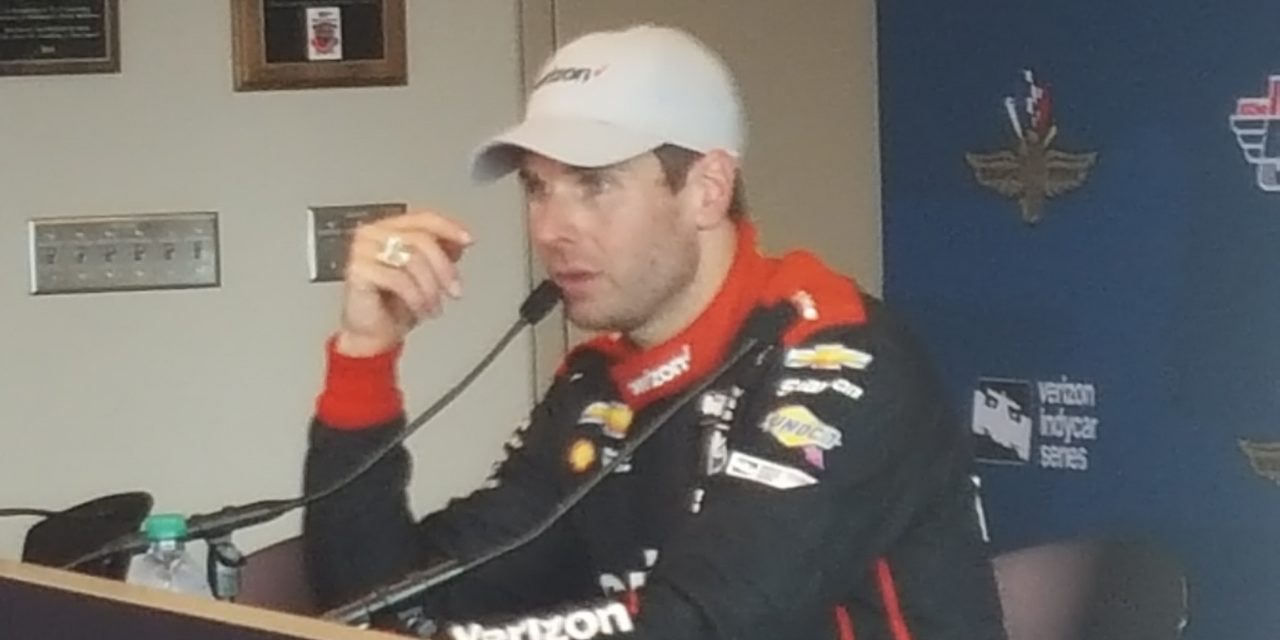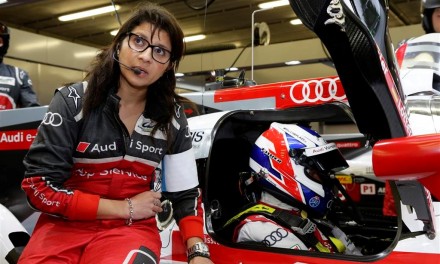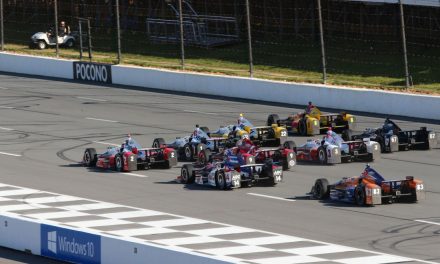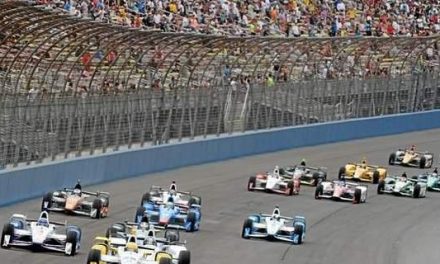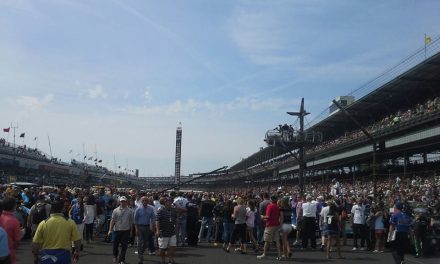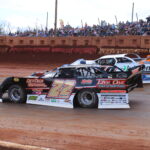Story and photo by Patrick Reynolds
INDIANAPOLIS- Indycar’s new speedway aero kits produced a tactical Indianapolis 500 as Australian Will Power gave team owner Roger Penske his 17th race win.
Honda and Chevrolet provided new bodywork to the existing tubs for 2018 and the Indy 500 racing changed in appearance. Gone were the pack racing and slingshot passes that the 500 has become known for since the DW-12 chassis was introduced in 2012. Replacing that, were importance of track position, fuel mileage, timing momentum on restarts, and drivers hanging on to their cars on the edge of control.
“This was a race you wanted to lead,” said Power. “If you had a good car, the leader could benefit and pull away. It definitely made it harder to drive.”
Drivers Losing Control
Single car spins and crashes peppered the 500 as drivers complained of understeer, then through chassis adjustments and driving compensation, rear tires were losing grip and spinning. Similar-style crashes occurred at several points on the track.
- Ed Jones was the first to spin out and crash into the turn two wall on lap 58.
- Danica Patrick, making her final career start before retiring from driving, had a similar crash in the same spot 10 laps later.
- Sebastian Bourdais, returning to the 500 after serious injuries here one year ago, continued the pattern on the track’s North Chute and came to rest against the turn four wall on lap 138.
- Three-time 500 Champion Helio Castroneves spun off turn four, hit the inside wall and slid into pit lane with 55 laps remaining. “Rear (grip) just gave up,” said Castroneves.
- Sage Karam caught the turn-four wall shortly after the Castroneves restart and came to rest on the frontstretch.
- 2013 500 Champ Tony Kanaan wound up against the second corner inside wall with 13 laps to go.
“The downforce level is maybe not necessarily the issue,” said Scott Dixon. “It’s almost like the cars need a little more drag to make that happen or maybe a little bit of downforce so you can stay closer.”
“The car is pretty tricky. It seems like you get a lot of understeer. At the end if you get some clean air maybe from the car, if you get high on the car in front of you, it can snap around pretty quickly,” Dixon said.
Power said it was “hard to get close” in dirty air. “My car was very close, a little bit loose, in clean air.”
Difficult To Pass
Track position was at a premium as drivers predicted earlier in the week. Passing was not impossible but certainly much more difficult than the 500’s previous six runnings.
This led to restarts being very aggressive as drivers took the opportunities to gain positions that they could not while racing.
- Zachary Claman De Melo was swarmed by polesitter Ed Carpenter and Kanaan heading into turn one on the day’s first restart following a crash between James Davison and 2017 winner Takuma Sato.
- Kanaan made a move on then-dominant Carpenter for the lead on the lap 63 restart.
- Alexander Rossi made some daring moves and passed multiple cars in the outside lane on consecutive restarts while engineering a fourth-place finish from 32nd on the grid.
- Dixon spent much of the race’s second half turning lap times two seconds slower than the leader in a strategic fuel saving attempt to win.
The end of the race came down to a mixture of the race’s template- fuel mileage, track position, and restarts.
Dixon saved fuel and was running 19th with 50 laps to go. The strategy was working well as he moved his way up to sixth place with 22 laps remaining while other teams headed for pit road and fuel.
Power took over fourth from Dixon with 15 laps to go.
“We tried to kind of figure out whether to keep going and hope for a yellow or try to save a bit of fuel,” Dixon said. “That’s why I let Will pass. Obviously on the restarts we had a few guys that couldn’t make it at all.”
Oriol Servia was the leader as the race went back to green after Kanaan’s crash but Stefan Wilson and Jack Harvey used the restart to overhaul Servia. Their tactic fell short with both heading to pit road with four laps left for fuel, and handing the lead to Power.
“I knew I had to get, like, a run on these guys, at least get one of them in the first turn, which I didn’t,” Power said. “I didn’t want Carpenter to have a shot at me. He was very quick.”
Carpenter said, “It was almost like being out front early probably hurt us a little bit because guys started saving fuel a little earlier. We got behind on the fuel save. Whatever segment Will got by us, went a couple laps further, my out lap we had traffic.”
The Australian was home free as Power crossed the yard of bricks under the double-checkered flags for his first-career Indy 500 win, over three seconds in front of runner-up Carpenter.
Dixon, 2016 winner Rossi, and 2014 champ Ryan Hunter-Reay rounded out the top five. Simon Pagenaud, Carlos Munoz, Josef Newgarden, Robert Wickens, and Graham Rahal completed the top-ten.
Highest-finishing rookie Wickens said, “We were actually getting great fuel mileage the whole day. We kept on going a couple laps longer than everyone else.”
“Track position was everything we thought it was going to be coming into the day,” said Wickens.
“It was just really tough to pass another strong competitor today without having lapped traffic, in the pit, or something else that was a mistake”, said Carpenter. “It was really hard to pass anybody if they had clean air in front of them.”
“The old car, if you had a really good car, you couldn’t get rewarded by getting away or getting separation,” said Carpenter. “I do think we need to maybe make little improvements just because it’s so hard in dirty air to do much, to even have a better (race) finish at the end.”
“In clean air, I was very aggressive on the restarts,” Power said. “Put the driver back into it more, where before you could hang back third, no one wanted to lead.”
Drivers enjoyed the new package and the feel of the cars. They felt more in control and let the setups and tire degradation management bring better teams to the front.
This was a clear variation from the automatic passing and close pack racing from the past.
A big pocket of air and an easy draft are part of an action-filled Indianapolis 500. So is fuel mileage, strategy, and pit work. The last two aero kits have leaned one way or another.
Drivers and teams weighed in favorably today. The fans will make their opinion known over which type of race they prefer.
Race Notes
- Power’s first 500 win also makes him the first driver to sweep May with his Grand Prix win two weeks ago.
- This was Power’s career win number 24 which tied him with Al Unser Jr. for eighth place on the all-time Indycar list.
- The pre-race ceremony- an emotional and moving build-up to the race- felt clumsy. There was dead time, music and videos that droned on, and a stealth bomber that flew over diagonally instead of squarely with the track design and was out of view from thousands of race fans. Danica Patrick: “But I found myself most of the time on the grid feeling confused. What part of prerace we were in? I was like, I don’t remember this. Where are the taps? When is the anthem?”
- National Weather Service stated that the high temperature was 91 degrees, tying this race for second hottest 500 on record. The hottest was 1937’s 92 degrees.
- Zach Veach had a fire on his left sidepod during a refueling stop. He exited the pits and the fuel burned itself out.
- Kanaan led for his 14th different Indy 500, A.J. Foyt held the previous record with leading in 13 races.
Patrick Reynolds is a former professional NASCAR mechanic who hosts Speedway Report live on Facebook Mondays 7:30 pm ET/ 4:30 pm PT and uploaded on http://speedwayreport.wpengine.com/ . Follow on Twitter @SpeedwayPat.

